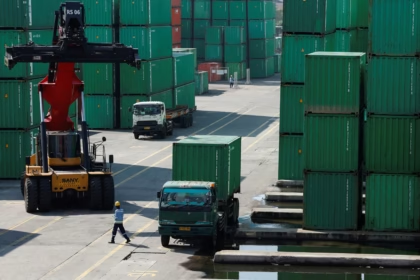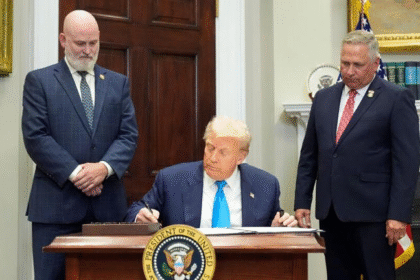Trump Slaps 25% Tariff on India, Cuts Trade Rates for Pakistan & Bangladesh in Shocking U-Turn
In a bold trade decision, Donald Trump enforces a steep 25% tariff on Indian goods while slashing duties on imports from Pakistan and Bangladesh. Explore the numbers, implications, and global reactions
US President Donald Trump has announced reciprocal tariffs on countries as the August 1 deadline came to an end. The administration has stuck to the 25% tariff on India. However, the “additional penalties”, which Trump had threatened to impose on India for doing business with Russia, remains unclear.
Pakistan, which announced a deal with the US on Thursday, has received a 19% tariff rate, while Bangladesh’s rate, which earlier stood at 35%, has been brought down to 20%. Pakistan was earlier hit with a 29% reciprocal tariff in April.
“These modifications shall be effective with respect to goods entered for consumption, or withdrawn from warehouse for consumption, on or after 12:01 a.m. eastern daylight time 7 days after the date of this order,” the White House statement said.

This means that the tariffs will take effect on August 7. White House officials told CNBC-TV18 exclusively that this should not be treated as an extension but just more time for the customs department to prepare their systems accordingly to collect the new tariffs.
In an interaction with CNBC on Thursday, US Treasury Secretary Scott Bessent said that the entire trade team is frustrated with India, as it has not been a great global actor due to its dealings with China.
The US has also decided to impose a 20% tariff on Taiwan, 19% each on Cambodia and Thailand, a 30% tariff on South Africa, and a 15% tariff on Turkey. The Trump administration has also imposed a 15% tariff on Israel and South Korea, along with a 39% tariff on Switzerland, which has triggered a fall in the Swiss Franc against the US Dollar.
Canada’s tariffs have also been raised to 35% from 25% earlier, after the country decided to recognise Palestine as an independent state. However, the goods compliant under the US-Mexico-Canada agreement have been exempt.
In the end, imports from about 40 countries will face the new 15% rate and roughly a dozen economies’ products will be hit with higher duties, either because they reached a deal or Trump sent them a letter unilaterally setting import taxes. The latter group has the highest goods-trade surpluses with the US.
In a stunning trade move that’s sending shockwaves across South Asia, former U.S. President Donald Trump has reaffirmed a 25% tariff on Indian exports while dramatically slashing tariff rates on imports from Pakistan and Bangladesh, signaling a strategic pivot that could redefine America’s trade priorities in the region.
This controversial trade recalibration—revealed during Trump’s high-voltage campaign rally in Michigan—has instantly ignited diplomatic tensions, raised economic alarms, and triggered strategic recalculations in New Delhi, Dhaka, and Islamabad.
Donald Trump’s decision to retain the 25% tariff on Indian steel and aluminum exports, originally imposed during his 2018 presidency, has now been repackaged as part of his “America First 2.0” policy.
“India has taken advantage of us for too long. We are fixing broken deals,” Trump told supporters.
The 25% tariff affects over $2.4 billion worth of Indian exports.
Industries impacted include steel, automotive parts, electronics, and textiles.
Indian officials call the decision “economically regressive and geopolitically short-sighted.”
In a stunning reversal, Trump announced tariff cuts of up to 70% on select imports from Pakistan and Bangladesh, effective immediately if he returns to office in 2025.
Pakistani textile imports to the U.S. now face only 5% tariffs, down from 17.5%.
Bangladeshi garment tariffs slashed from 15.6% to 4.2%.
Combined exports from both nations to the U.S. exceed $11 billion annually.
This move is seen as part of Trump’s push to build manufacturing alternatives to China and counter India’s growing tech and defense ties with the Biden administration.
India’s Ministry of Commerce immediately issued a statement calling the policy “discriminatory and damaging to Indo-U.S. relations.”
“Targeting India while rewarding nations with weaker democratic institutions raises questions,” said a senior Indian diplomat.
Meanwhile, U.S. business lobbies like the National Association of Manufacturers (NAM) expressed concern that punishing India, a key Quad ally, could backfire economically.
Pakistani Prime Minister Shehbaz Sharif welcomed the decision, hailing Trump’s “pragmatic support for regional balance.” Bangladesh’s Commerce Ministry said the new trade window could create 500,000+ new garment jobs in the country.
Analysts believe the move could:
Strain U.S.-India defense cooperation, especially in the Indo-Pacific.
Strengthen U.S. ties with Pakistan and Bangladesh, both of which are seen as volatile but strategically located.
Undermine Quad unity (India, U.S., Australia, Japan) amid rising tensions with China.
“This is not just economics; it’s raw geopolitics,” said Dr. Amy Carlson, a trade expert at the Brookings Institution.
25% Tariff on India: Continues to hurt Indian exporters, especially in metals and electronics.
Massive Relief for Pakistan & Bangladesh: Could boost textile and apparel sectors, shift supply chains.
$15 Billion Trade Realignment: May significantly alter South Asia’s export dynamics to the U.S.
2024 Election Strategy: Trump appears to be using trade policy to rally key manufacturing states and anti-China voters.
As the 2024 U.S. elections approach, Trump’s tariff moves are once again making headlines and unsettling global trade equations. While his hardline stance on India could alienate allies, the generous breaks to Pakistan and Bangladesh raise eyebrows across diplomatic corridors.
If Trump returns to power, expect a seismic shake-up in U.S.-Asia trade relations, with over $50 billion in annual trade on the line—and India firmly in the crosshairs.
Read Also : President Lula’s Bold Defiance Pays Off: Trump Backs Down on Brazil Tariffs After 6-Month Standoff








